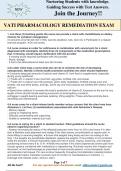Nurturing Students with knowledge.
Guiding Success with Test Answers.
NEW
Join the Journey!!
VATI PHARMACOLOGY REMEDIATION EXAM
1. List three (3) teaching points the nurse can provide a client with cholelithiasis on dietary
choices for symptom management.
● Consume a low-fat diet rich in HDL sources (seafood, nuts, olive oil). ● Participate in a regular
exercise program. ● Do not smoke.
2.A nurse reviews an order for ceftriaxone in combination with vancomycin for a client
diagnosed with meningitis. Identify three (3) components of the medication prescriptions
that, if missing, would require clarification with the provider
· If missing would required clarification with the provider.
· Route, dosage
· It has to be administered at least over 60 minutes.
3.An older client asks a nurse what she can do to minimize the risk of developing
osteoporosis. Identify 3 (three) health promotion activities the client should implement.
● Consume adequate amounts of calcium and vitamin D, from food or supplements, especially
during young adulthood.
◯ Foods rich in vitamin D are most fish, egg yolks, fortified milk, and cereal.
◯ Foods rich in calcium are milk products, green leafy vegetables, fortified orange juice and
cereals, red and white beans, and figs. Some soy and rice products are fortified with vitamin D and
calcium.
● Spend time outdoors to increase the body's production of vitamin D. Exposure to the sun for any
length of time should include wearing sunscreen to avoid getting a sunburn.
● Engage in weight-bearing exercises (walking, lifting weights). These activities promote bone
rebuilding and maintenance
4.A nurse cares for a client whose family member voices concern that the client may have
Alzheimer's. List four (4) manifestations associated with mild Alzheimer's Disease.
· Memory lapses
· Losing or misplacing items
· Difficulty concentrating and organizing.
· Unable to remember material just read.
5.A nurse is caring for a client in skeletal traction. What guidelines should the nurse
observe regarding traction?
· Assess neurovascular status of the affected body part every hour for 24 hr and every 4 hr after
that. ● Maintain body alignment and realign if the client seems uncomfortable or reports pain. ●
Avoid lifting or removing weights. ● Ensure that weights hang freely and are not resting on the
floor. f the weights are accidentally displaced, replace the weights. If the problem is not corrected,
notify the provider. ● Ensure that pulley ropes are free of knots, fraying, loosening, and improper
positioning at least every 8 to 12 hr. ● Notify the provider if the client experiences severe pain from
muscle spasms unrelieved with medications or repositioning. Routinely monitor skin integrity and
document. ● Use heat/massage as prescribed to treat muscle spasms. ● Use therapeutic touch
and relaxation techniques. Pin care is done frequently throughout immobilization (skeletal traction
and external fixation methods) to prevent and to monitor for manifestations of infection. ◯
Drainage and redness (color, amount, odor)
Page 1 of 7
All the best!! For any queries/ more documents email: alldocs4sale@gmail.com
, 6.A nurse is providing discharge teaching to a client following a permanent pacemaker
insertion. List four (4) important teaching points that need to be included.
◯ Take pulse daily at the same time for those with pacemakers or combination devices. Notify the
provider if heart rate is less than the pacemaker rate.
◯ Report dizziness, fainting, fatigue, weakness, chest pain, hiccuping, palpitations, difficulty
breathing, or weight gain
◯ Never place items that generate a magnetic field directly over the pacemaker generator. These
items can affect function and settings. This includes garage door openers, burglar alarms, strong
magnets, generators and other power transmitters, and large stereo speakers. The use of
household items is not prohibited.
◯ Inform airport security personnel about the presence of a pacemaker/ICD, because it will set off
airport security detectors. The airport security device should not affect pacemaker functioning.
Airport security personnel should not place wand detection devices directly over the pacemaker or
ICD.
7.The nurse is performing a focused gastrointestinal assessment on a client who
complains of fever and abdominal pain for 2 days. What additional assessment findings
alert the nurse to the possibility of appendicitis?Suggested Adult Med Surg Learning
Activity: Appendicitis
● Abdominal pain in the right lower quadrant ● Rigid abdomen ● Decreased or absent bowel
sounds ● Fever ● Diarrhea or constipation ● Lethargy ● Tachycardia ● Rapid, shallow breathing ●
Anorexia ● Possible vomiting
Computed tomography scan shows an enlarged diameter of appendix, as well as thickening of the
appendiceal wall.
8.Digoxin teaching
Many remember to hold digoxin for HR < 60 in adults, but don't know for children and infants. Hold
for HR < 70 in children and HR < 90 in infants.
Did you know there are herbals that interact with warfarin? Remember the 4 G's: ginseng, garlic,
ginkgo biloba, and ginger
9.A client is refusing to take morning medications. How should the nurse respond?
Respect the client's right to refuse any medication. Explain the consequences, inform the provider,
and document the refusal.
10.A new nurse is orienting to the labor and delivery unit. List three (3) potential adverse
effects this new nurse should know prior to administering oxytocin
uterine rupture, uterine tachysystole, placental abruption
11.A nurse is caring for a newborn whose mother is an alcoholic. Describe withdrawal
symptoms this newborn may exhibit.
Jitteriness, irritability, increased tone and reflex responses, seizures
12.A 36-year-old client is prescribed digoxin for heart failure. What are two (2)
contraindications for the use of digoxin?Suggested Pharmacology Learning Activity: Heart
Failure
-Contraindicated in clients who have disturbances in ventricular rhythm, including ventricular
fibrillation, ventricular tachycardia, and second-and third-degree heart block.
-Use cautiously in clients who have hypokalemia, partial av block, advanced heart failure, and
impaired kidney function.
13.A nurse is caring for a surgical client who is prescribed neostigmine for treatment of -
myasthenia gravis. List two (2) potential adverse effect the nurse should be aware of while
providing this treatment
Page 2 of 7
All the best!! For any queries/ more documents email: alldocs4sale@gmail.com




